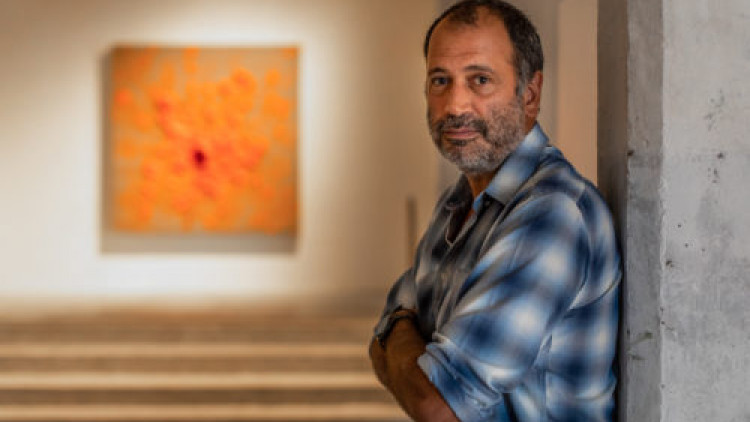Bosco Sodi will create an artwork that will respond to the desires of the commissioners of Boom

This art work will not only serve as an indictment of the industrial past, It will also become a guard of the new ecological location.
The village of Boom, located in Flanders in Belgium, was one of the most important producers of brick in Europe, made from clay dug up and extracted from the local soil. While this led to wealth in the second half of the 19th and first half of the 20th century, the industry collapsed around 1970s when the clay quarries became exhausted. Until this day, Boom knows poverty, the soil impoverished and depleted by the brick industry. The industrial past still has had an everlasting effect on the landscape of Boom, and by extension its inhabitants.
Where the commissioners’ focus initially was on commemorating Boom's glorious industrial past, their vision changed during the discussions we had since the start of ‘Clay Commons’ in the beginning of 2023. During these meetings, the commissioners’ criticism of the industry became apparent, clearly showing their love-hate relationship with this important but very tragic past. Although the brick industry brought prosperity and growth, only a limited group of people benefited.
The vast majority of citizens of Boom lived in poverty and performed hard physical labor. This worsened with the collapse of the industry in the 1970s, resulting in an all-time high rise of unemployment among the population. Moreover, the brick industry was very polluting. Not only did the production process release toxins into the air, residual waste was subsequently dumped in the ground and covered up.
After visiting the site intended for the art work, the conversations culminated further. Used for years as a dump for bricks and other waste, the location, close to the border with Rumst, will revive in the future as an ecological park. Over the coming years, it will be remediated by using sandy soil retrieved by major infrastructure works near Antwerp. Despite promises by the authorities that the ground poses no threat to public health, there is fear among the citizens.
They worry history will repeat itself. Strengthened by past experiences, there is a new vigilance and awareness among them, which the commissioners want to have translated into a work of art on that site. This art work will not only serve as an indictment of the industrial past. It will also become a guard of the new ecological location.
The artist is thus expected to contribute to awareness of the past and future of Boom's landscape. The work will serve as an indictment against Booms’ industrial heritage and its terrible consequences, as well as be a guard of the future ecological development of the site. Due to the specific situation in Boom, the artist is expected to use the material clay as a starting point for his artistic intervention.
After more than a year of mediation work with many discussions and reflection, the Mexican artist Bosco Sodi (1970, Mexico City) has been chosen to create an art work that will respond to the desires of the commissioners of Boom. Sodi is best known for his use of raw natural materials to create his large-scale textured paintings and sculptures.
Within his oeuvre clay, as a natural material, plays a very important role. For Sodi, it is one of the few materials that has a universal character. Clay transcends and unites different cultures.
“Clay is an important factor in human evolution. It is one of the materials used by people to transport oil or water. It is connected with every culture on different levels”
Due to his realised large clay sculptures and his consequent knowledge of the (traditional) clay baking process, Sodi has a lot of expertise and attention for clay and the (different) way it is produced. This knowledge is vital for the commissioners, who want to see their history with clay be reflected in the art work. They are also drawn to Sodi’s work due to his monumental and spatial visual language.
The coming months, Sodi will dive deep into this commission. He will meet the commissioners, and explore the territory and site intended for the art work. Sodi will also look into the communal knowledge about the industrial past of Boom, as well as the characteristics of its clay and its production process in order to design an art work that will respond best to the wishes of the commissioners.
Bosco Sodi has exhibited his work internationally and throughout the United States. In 2022, the Fondazione dell’Albero d’Oro organized the solo exhibition What Goes Around Comes Around at the Palazzo Vendramin Grimani in Venice, Italy. The University of South Florida Contemporary Art Museum in Tampa staged the solo exhibition Básico in the same year. In 2021, Sodi opened a major sculpture show in the garden at Dallas Museum of Art, and completed his second public installation, Tabula Rasa, in Washington Square Park. Other notable institutional exhibitions include ergo sum, Centro de Arte Contemporáneo de Málaga, Spain (2020); Por los siglos de los siglos, Museo Nacional de Arte, Mexico City (2017); Museum of Stones, the Noguchi Museum, New York (2015); and Pangea, Bronx Museum, New York (2010). His work is also featured in significant public and private collections worldwide.
Photo: Portrait of the artist Bosco Sodi Portrait of the artist, Bosco Sodi, in front of his work at Kanaal (2018) - © Axel Vervoordt Gallery and Sebastian
